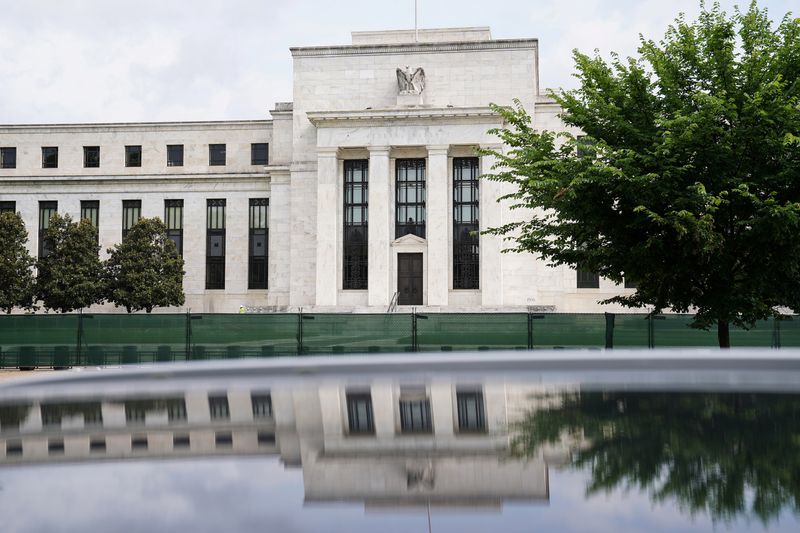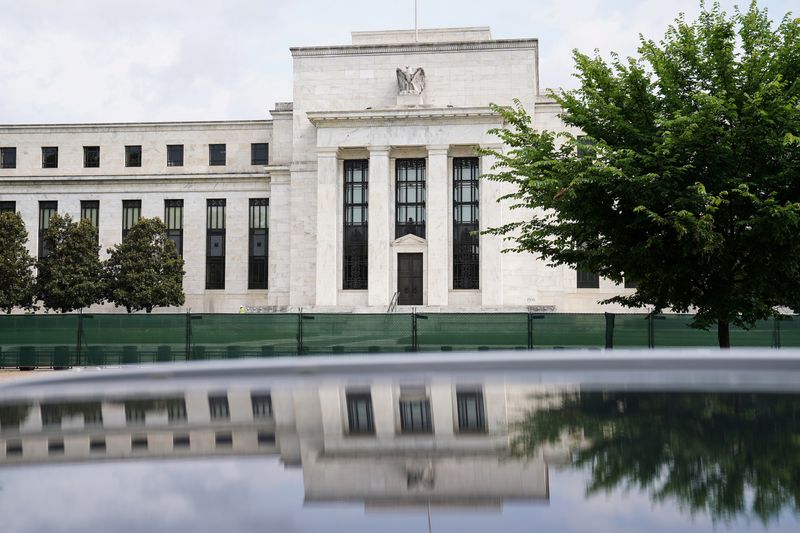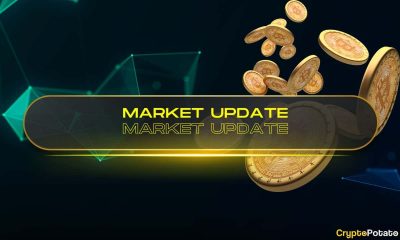Economy
Fed doves, Fed hawks: a look at how U.S. central bankers fly


© Reuters. The exterior of the Marriner S. Eccles Federal Reserve Board Building is seen in Washington, D.C., U.S., June 14, 2022. REUTERS/Sarah Silbiger
(Reuters) – The labels “dove” and “hawk” have long been used by central bank watchers to describe the monetary policy leanings of policymakers, with a dove more focused on risks to the labor market and a hawk more focused on the threat of inflation.
The topsy-turvy economic environment of the coronavirus pandemic sidelined those differences, turning Fed officials at first universally dovish as they sought to provide massive accommodation to a cratering economy, and then, when inflation surged, into hawks who uniformly backed aggressive rate hikes. Now, divisions are more evident, and the choices – to raise rates again, skip for now but stay poised for more later, or take an extended pause – more varied.
All 12 regional Fed presidents discuss and debate monetary policy at Federal Open Market Committee meetings, held eight times a year, but only five cast votes at any given meeting, including the New York Fed president and four others who vote for one year at a time on a rotating schedule.
The following graphic offers a stab at how officials stack up on their outlook for Fed policy and how to balance their goals of stable prices and full employment. The designations are based on comments and published remarks; for more on the thinking that shaped these hawk-dove designations, click on the photos in the graphic.
Dove Dovish Centrist Hawkish Hawk
Austan John Jerome Chistopher
Goolsbee, Williams, Powell, Fed Waller,
Chicago Fed New York Chair, Governor,
President, Fed permanent permanent
2023 voter: President, voter: “It is voter: “If
“Hopefully permanent certainly inflation
we’re going to voter: “To possible that does not
continue to me, the we would continue to
see debate is raise the show
improvement on really (federal) progress
the inflation about: Do funds rate and there
front.” Aug 1, we need to again at the are no
2023 do another September suggestions
rate meeting if of a
increase? the data significant
Or not?” warranted, slowdown in
Aug 2, and I would economic
2023 also say it’s activity,
possible that then a
we would second
choose to 25-basis-po
hold steady int hike
at that should come
meeting.” sooner
July 26, 2023 rather than
later”
after the
July rate
hike. July
13, 2023
Patrick Lisa Cook, Philip Michelle
Harker, Governor, Jefferson, Bowman,
Philadelphia permanent Governor and Governor,
Fed President, voter: Vice Chair permanent
2023 voter: “If Designate, voter: “I
“Absent any confirmed, permanent expect that
alarming new I will voter: “The additional
data between stay economy faces increases
now and focused on multiple will likely
mid-September, inflation challenges, be needed
I believe we until our including to lower
may be at the job is inflation, inflation
point where we done.” banking-secto to the
can be patient June 21, r stress, and (Federal
and hold rates 2023 geopolitical Open Market
steady.” Aug instability. Committee’s
8, 2023 The Federal ) goal.”
Reserve must Aug. 7,
remain 2023
attentive to
them all.”
June 21, 2023
Raphael Susan Michael Barr, Loretta
Bostic, Collins, Vice Chair of Mester,
Atlanta Fed Boston Fed Supervision, Cleveland
President, President, permanent Fed
2024 voter: 2025 voter: “I’ll President,
“I’d like if voter: “We just say for 2024 voter:
at all may be at, myself, I “My view is
possible to or near, think we’re that the
make sure we the point close.” July funds rate
don’t do too where 10, 2023 will need
much, and do monetary to move up
more than is policy can somewhat
necessary to pause further
get us to that raising from its
2% target..” interest current
Aug 1, 2023 rates.” level and
May 25, then hold
2023 there for a
while.”
July 10,
2023
Mary Daly, San Neel
Francisco Fed Kashkari,
President, Minneapolis
2024 voter: Fed
“Whether we President,
raise another 2023 voter:
time, or hold “We’re making
rates steady good
for a longer progress, and
period — we’re staying
those things on it. If we
are yet to be need to hike-
determined.” raise rates
Aug. 10, 2023. further from
here, we will
do so.” July
30, 2023
Lorie Logan,
Dallas Fed
President,
2023 voter:
“The
continuing
outlook for
above-target
inflation and
a
stronger-than
-expected
labor market
calls for
more-restrict
ive monetary
policy.” July
6, 2023
Thomas
Barkin,
Richmond Fed
President,
2024 voter:
“We have time
before the
next meeting
… to figure
out whether
the various
forecasts of
where the
economy is
going come
true.” Aug 8,
2023
Note: Fed policymakers have been driving up borrowing costs since March 2022 to bring down high inflation, and in July they increased the target policy rate range to 5.25%-5.5%. Most policymakers as of June expected at least one more rate hike by year’s end. Longtime banker Jeff Schmid starts as Kansas City Fed president Aug. 21, and will be a voter in 2025. St. Louis Fed President James Bullard, a vocal policy hawk, left the Fed in July for a job in academia; the new chief will be a 2025 voter.
(Reporting Ann Saphir, Howard Schneider, Michael S. Derby and Dan Burns; Editing by Andrea Ricci)
Economy
Russian central bank says it needs months to make sure CPI falling before rate cuts -RBC


© Reuters. Russian Central Bank Governor Elvira Nabiullina attends a news conference in Moscow, Russia June 14, 2019. REUTERS/Shamil Zhumatov/File Photo
MOSCOW (Reuters) – Russia’s central bank will need two to three months to make sure that inflation is steadily declining before taking any decision on interest rate cuts, the bank’s governor Elvira Nabiullina told RBC media on Sunday.
The central bank raised its key interest rate by 100 basis points to 16% earlier in December, hiking for the fifth consecutive meeting in response to stubborn inflation, and suggested that its tightening cycle was nearly over.
Nabiullina said it was not yet clear when exactly the regulator would start cutting rates, however.
“We really need to make sure that inflation is steadily decreasing, that these are not one-off factors that can affect the rate of price growth in a particular month,” she said.
Nabiullina said the bank was taking into account a wide range of indicators but primarily those that “characterize the stability of inflation”.
“This will take two or three months or more – it depends on how much the wide range of indicators that characterize sustainable inflation declines,” she said.
The bank will next convene to set its benchmark rate on Feb. 16.
The governor also said the bank should have started monetary policy tightening earlier than in July, when it embarked on the rate-hiking cycle.
Economy
China identifies second set of projects in $140 billion spending plan


© Reuters. FILE PHOTO: Workers walk past an under-construction area with completed office towers in the background, in Shenzhen’s Qianhai new district, Guangdong province, China August 25, 2023. REUTERS/David Kirton/File Photo
SHANGHAI (Reuters) – China’s top planning body said on Saturday it had identified a second batch of public investment projects, including flood control and disaster relief programmes, under a bond issuance and investment plan announced in October to boost the economy.
With the latest tranche, China has now earmarked more than 800 billion yuan of its 1 trillion yuan ($140 billion) in additional government bond issuance in the fourth quarter, as it focuses on fiscal steps to shore up the flagging economy.
The National Development and Reform Commission (NDRC) said in a statement on Saturday it had identified 9,600 projects with planned investment of more than 560 billion yuan.
China’s economy, the world’s second largest, is struggling to regain its footing post-COVID-19 as policymakers grapple with tepid consumer demand, weak exports, falling foreign investment and a deepening real estate crisis.
The 1 trillion yuan in additional bond issuance will widen China’s 2023 budget deficit ratio to around 3.8 percent from 3 percent, the state-run Xinhua news agency has said.
“Construction of the projects will improve China’s flood control system, emergency response mechanism and disaster relief capabilities, and better protect people’s lives and property, so it is very significant,” the NDRC said.
The agency said it will coordinate with other government bodies to make sure that funds are allocated speedily for investment and that high standards of quality are maintained in project construction.
($1 = 7.1315 renminbi)
Economy
Russian central bank says it needs months to make sure CPI falling before rate cuts -RBC


© Reuters. Russian Central Bank Governor Elvira Nabiullina attends a news conference in Moscow, Russia June 14, 2019. REUTERS/Shamil Zhumatov/File Photo
MOSCOW (Reuters) – Russia’s central bank will need two to three months to make sure that inflation is steadily declining before taking any decision on interest rate cuts, the bank’s governor Elvira Nabiullina told RBC media on Sunday.
The central bank raised its key interest rate by 100 basis points to 16% earlier in December, hiking for the fifth consecutive meeting in response to stubborn inflation, and suggested that its tightening cycle was nearly over.
Nabiullina said it was not yet clear when exactly the regulator would start cutting rates, however.
“We really need to make sure that inflation is steadily decreasing, that these are not one-off factors that can affect the rate of price growth in a particular month,” she said.
Nabiullina said the bank was taking into account a wide range of indicators but primarily those that “characterize the stability of inflation”.
“This will take two or three months or more – it depends on how much the wide range of indicators that characterize sustainable inflation declines,” she said.
The bank will next convene to set its benchmark rate on Feb. 16.
The governor also said the bank should have started monetary policy tightening earlier than in July, when it embarked on the rate-hiking cycle.

 Forex2 years ago
Forex2 years agoForex Today: the dollar is gaining strength amid gloomy sentiment at the start of the Fed’s week

 Forex2 years ago
Forex2 years agoHow is the Australian dollar doing today?

 Forex1 year ago
Forex1 year agoUnbiased review of Pocket Option broker

 Forex2 years ago
Forex2 years agoDollar to pound sterling exchange rate today: Pound plummeted to its lowest since 1985

 Cryptocurrency2 years ago
Cryptocurrency2 years agoWhat happened in the crypto market – current events today

 World2 years ago
World2 years agoWhy are modern video games an art form?

 Stock Markets2 years ago
Stock Markets2 years agoMorgan Stanley: bear market rally to continue

 Economy2 years ago
Economy2 years agoCrude oil tankers double in price due to EU anti-Russian sanctions

































